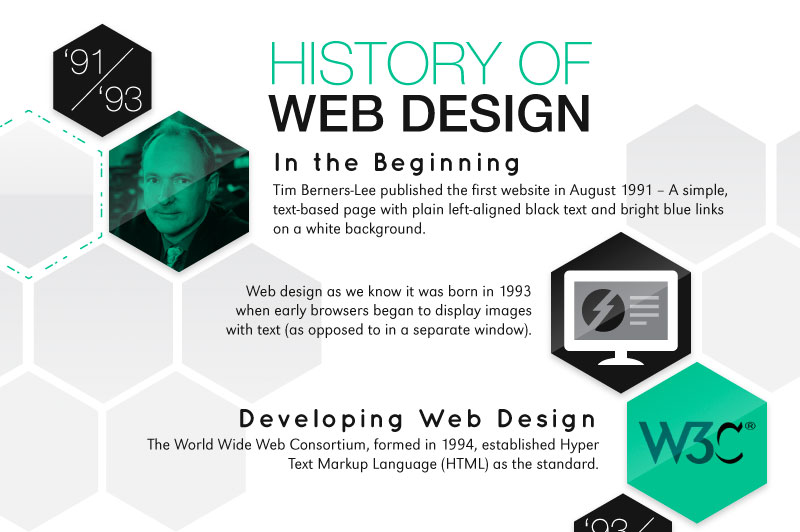Interested In Discovering Just How Site Style Has Changed Over The Years? Discover The Trip
Interested In Discovering Just How Site Style Has Changed Over The Years? Discover The Trip
Blog Article
Content By-Kahn Trolle
In the past, internet sites were basic and focused on information. Navigation was direct, and style was for desktop computers. Currently, customer experience is essential. Information guides styles for easy navigation. Receptive layouts fit different tools. Today, dark setting decreases pressure, and minimalist food selections enhance navigation. Interactive features involve customers, and vibrant visuals stand out. AI integration improves interaction. See exactly how layout has actually evolved to enhance your on the internet trip.
Very Early Days of Website Design
In the very early days of website design, simpleness reigned supreme. Websites were basic, with minimal colors, font styles, and layouts. The focus was on offering information rather than fancy visuals. Users accessed the internet via sluggish dial-up links, so speed and functionality were key.
Navigating menus were straightforward, normally situated at the top or side of the page. Websites were designed for desktop, as mobile browsing had not been yet widespread. Material was king, and designers prioritized easy readability over complicated style components.
HTML was the key coding language utilized, and developers needed to function within its constraints. Animations and interactive features were minimal contrasted to today's criteria. Websites were fixed, with little vibrant material or personalized user experiences.
Rise of User-Focused Style
With the development of web site layout, a shift in the direction of user-focused layout principles has actually become progressively famous. Today, developing internet sites that prioritize customer experience is vital for involving site visitors and achieving organization goals. User-focused style entails understanding the needs, choices, and actions of your target market to customize the website's format, web content, and includes accordingly.
Designers currently perform detailed research, such as user studies and functionality screening, to gather insights and comments directly from individuals. This data-driven strategy aids in producing user-friendly navigation, clear calls-to-action, and visually attractive user interfaces that resonate with site visitors. By positioning the individual at the center of the style process, web sites can supply a more personalized and satisfying experience.
Receptive style has also become a vital aspect of user-focused layout, ensuring that websites are optimized for various gadgets and display sizes. This versatility enhances availability and functionality, catering to the diverse means users connect with internet sites today. Basically, the rise of user-focused style indicates a shift in the direction of creating electronic experiences that prioritize the requirements and expectations of the end customer.
Modern Trends in Website Design
Explore the most recent patterns shaping web design today. One famous fad is dark setting layout, providing a sleek and modern-day look while reducing eye strain in low-light environments. Another essential fad is minimal navigation, simplifying menus and boosting customer experience by concentrating on essential elements. Including micro-interactions, such as computer animated switches or scrolling effects, can create a more engaging and interactive web site. https://www.campaignlive.com/article/marketing-leaders-prepare-recession/1791819 remains essential, making sure smooth individual experiences throughout different tools. Additionally, using vibrant typography and asymmetrical designs can add visual passion and draw attention to certain web content.
Integrating AI innovation, like chatbots for customer assistance or customized referrals, boosts individual involvement and improves procedures. Ease of access has likewise become a considerable fad, with developers focusing on inclusive layout techniques to satisfy diverse user requirements. Welcoming search engine optimisation expert by enhancing internet site efficiency for speed and performance is another arising pattern in web design. Working together with user feedback and information analytics to iterate and boost style continually is vital for staying pertinent in the ever-evolving electronic landscape. By embracing these modern-day trends, you can produce an aesthetically enticing, user-friendly website that reverberates with your audience.
Verdict
As you assess the advancement of website style from the very early days to now, you can see how user-focused style has become the driving force behind contemporary patterns.
Embrace the trip of change and adaptation in web design, always maintaining the individual experience at the forefront.
Keep existing with the most recent patterns and innovations, and never stop evolving your technique to develop aesthetically magnificent and easy to use web sites.
Progress, adjust, and develop - the future of web design remains in your hands.
